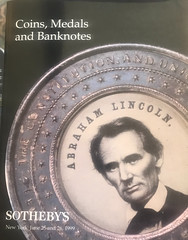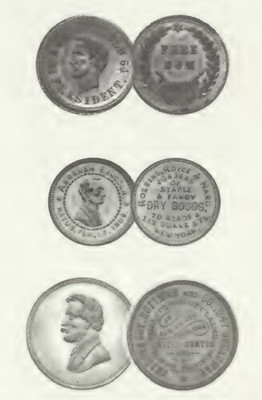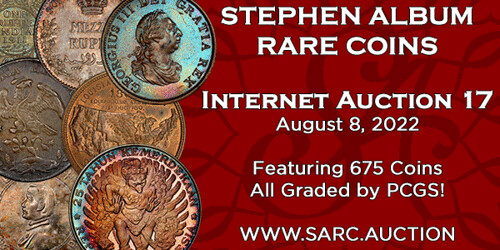
PREV ARTICLE
NEXT ARTICLE
FULL ISSUE
PREV FULL ISSUE
V25 2022 INDEX E-SYLUM ARCHIVE THE ZABRISKIE LEGACYAlthough the primary coin collection of Capt. Andrew Zabriskie was sold by Henry Chapman, another sale took place at a much later date as discussed in The E-Sylum last year. The July 1999 issue of The Rail Splitter has a cover article by Donald Ackerman titled "The Zabriskie Legacy" with a sidebar article by David E. Tripp. With permission, we're republishing these here. -Editor
THE ZABRISKIE LEGACY
Few collectors of political Americana know the name Andrew C. Zabriskie. But numismatists (coin collectors) are more than familiar with that moniker —- and, more importantly, what it represents in the way of provenance. Zabriskie was one of the most prominent collectors of American coinage in the late-nineteenth and early twentieth centuries. In fact, Zabriskie served as President of the American Numismatic Society at the turn-of-the-century. The sale of his collection by Henry Chapman in 1909 is considered, even today, a seminal event.
Ancient history... why then, should today's Lincoln collector be concerned with him? For one thing, he amassed what will always be considered the single finest assemblage of Lincoln tokens, medals, and political badges. Second, in 1873, at the age of nineteen, he published — at his own expense — the very first catalog devoted
exclusively to Lincoln medals: A Descriptive Catalogue of the
Political and Memorial Medals Struck in Honor of Abraham
Lincoln, Sixteenth President of the United States. A total of 187
medals (including metal varieties) were each assigned a number
(a
The symbiotic cord between coin collecting and political
collecting has its antecedents in the mid-nineteenth century.
Prior to the introduction of the photographic campaign badge in
1860, practically all campaign
Although most coin collectors profess an
interest in history, most are content to discover history through coins alone - politicals
are hardly worth the study. (Perhaps politicians are not deemed worthy of their attention.) But this was certainly not the case with
Zabriskie. In his 1897 lecture entitled As is well known, the fear of possible monarchical tendencies, in the days preceding the adoption of the Federal Constitution, prevented the use of any head, except that of the Goddess of Liberty, on regular issues of the coins of the United States. Looking back as we do, through a vista of more than one hundred years, it seems a pity that this phantom prevented the placing the bust of each President on the coins issued during his administration. This would have added an interest to the numismatic history of our country almost impossible to overestimate. We have, however, a series which in a degree can serve to make up this lack, and which in some respects is even more interesting than would have been a series of coins of the United States bearing the busts of the presidents. The series of coins bearing the busts of the presidents would delineate those candidates who were successfully chosen to rule over this country. The political series on the other hand not only delineates these successful candidates, but also shows us the features of those who strove in vain for the highest office within the gift of the republic. The seeds of the Captain's fascination with the contemporary political scene were defined by specific memories: I can distinctly recollect, as a boy, playing with a small American flag which had stamped across it the words ‘Clay and Frelinghuysen.' It was the sole surviving specimen of a number which had waved from my grandfather's house at 618 Broadway, when the great campaign procession took place... My own personal reminiscences of Mr. Lincoln are of the briefest character. I remember, as a boy of seven, seeing him as he was escorted through this city [New York] on his way to Washington for his inauguration, and recall my surprise that so many persons should crowd the streets to see this unassuming man drive by in a barouche, and whose only escort consisted of a few policemen and committeemen in carriages. With boyish recollections of the splendors accorded in their reception to the Japanese Embassy and the Prince of Wales in the previous year, my wonder is perhaps quite excusable. I remember four years later how, with awe-struck face, I watched the slow progress up Fifth Avenue of that solemn funeral car drawn by sixteen somber steeds and surrounded by the gray files of the Seventh Regiment. Years later, Zabriskie would speculate on the popularity of collecting political medals: In the year 1857 the United States government abolished the old copper cent and substituted the small nickel cent. This event had a very important bearing on American Numismatics; up to that time collectors of coins and medals had indeed been very few in number and societies devoted to the study of the science were entirely unknown in this country. It seems, however, to have occurred to a number of persons that the old copper cents were interesting, that a complete set of them would be a valuable thing to possess, and consequently, many started to collect sets of cents and half cents, as the half cent, which had been issued from time to time up to this year, had been abolished also. Many of these collectors, starting in a modest way, soon increased the field of their labors and gathered specimens of coins and medals of all countries. Naturally the interesting series of political medals attracted their attention...
Just why Zabriskie was attracted to collecting Lincoln is uncertain. The tumultuous
events of the Civil War, to which he was an
impressionable witness, were, no doubt, fertile
ground. Current events often hold the greatest
attraction for a beginning collector.
Affordability and availability may have been
other concerns. Accordingly, he came out with
his
The preface to his inaugural work was
simple and direct:
For those unfamiliar with the term,
One result of the catalog's publication
was a controversy between the author and a
Cambridge, Massachusetts collector named
Henry W. Holland. They traded barbs in a
series of
Zabriskie responded:
Zabriskie's I do not know of anyone quite measuring up to Capt. Andrew C. Zabriskie as a thoroughly kind and courteous gentleman, and I do not believe that I ever destroyed one of his letters, which were a great help to me in those days, as his collection was particularly strong in contemporaneous pieces, having been collected by him at time of issue or shortly after. During the early days of our acquaintance he presented me with a copy of his Lincoln Medal Catalog, the earliest of this kind and now quite rare, having an auction record of about $15. I have besides this many items in my collection presented me by him, medals as well as other things that somehow seem to appeal to a Lincoln collector's heart - photos, badges, etc., among the latter being a beautiful silk woven ribbon by Dreyfus, of Basle, Switzerland, which I value very highly.
Zabriskie spent his remaining years writing papers and delivering lectures on diverse topics, often returning to his first love -
election medals and Lincoln. Comments made in his paper ...In speaking to-night upon the Medallic Memorials of Abraham Lincoln, I am, as it were, opening to you one of the side galleries in the life of that great man, and am not guilty of the presumption of attempting to lead your steps along the well-known paths of his life, already made so familiar to you by the many excellent biographies that have appeared from time to time ... varying in value from what may be pronounced excellent and readable, to the somewhat scurrilous vaporings of Mrs. Lincoln's colored waiting-maid... Months before the action of the convention was known, the Republicans had begun the formation of the Wide Awake organization which proved such an important factor in the campaign ... In the hats of some of these campaign clubs was worn a tin badge [DeWitt AL1860-1], bearing a hideous likeness of Mr. Lincoln. These are now rare, and how I came to possess this one may be worth relating. Perhaps twenty years ago, seeing it catalogued for sale at auction, I sent a bid of two dollars for it, and afterwards was astounded to hear that it had sold for forty-two dollars. Some years later the purchaser sold it with his collection, and when I repeated my modest bid of two dollars my patience was rewarded by securing it for the small sum of one dollar and twenty-five cents. And here is a badge which I, as a boy of eleven, wore during the fall of 1864. Little campaigning was done, and the Wide Awakes had disappeared, but such campaign organizations as were formed were known as War Eagles... My task is finished... Like shells which strew the beach after the retreating tide, these little pieces of tin, or copper, or silver are left to us to mark the career of Abraham Lincoln.
And we, the collectors of today, have people like Andrew
Zabriskie to thank for his research, dedication, and diligence in
preserving these
For more information on The Rail Splitter, see:
To read the earlier E-Sylum article, see:
Wayne Homren, Editor The Numismatic Bibliomania Society is a non-profit organization promoting numismatic literature. See our web site at coinbooks.org. To submit items for publication in The E-Sylum, write to the Editor at this address: whomren@gmail.com To subscribe go to: https://my.binhost.com/lists/listinfo/esylum All Rights Reserved. NBS Home Page Contact the NBS webmaster 
|



